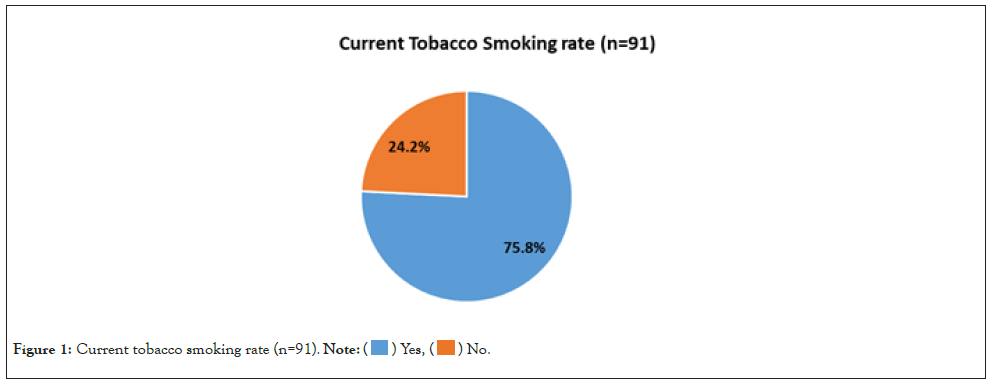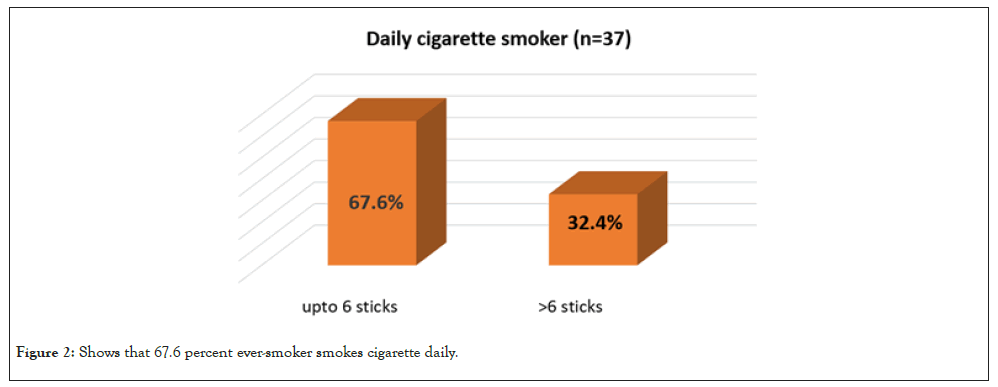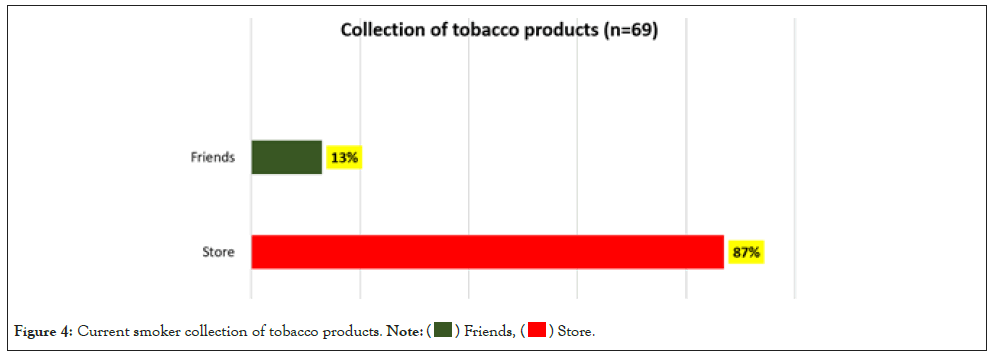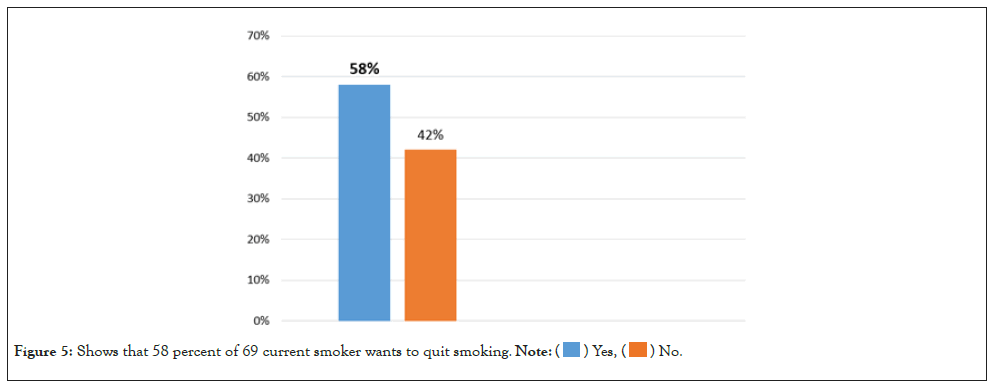Pediatrics & Therapeutics
Open Access
ISSN: 2161-0665
ISSN: 2161-0665
Research Article - (2023)Volume 13, Issue 1
Background: Tobacco is one of the major preventable leading causes of death in the world. In Bangladesh, about 56.4 percent of smokers started smoking at age of 12-13 years.
Objectives: This study was aimed to find out the status of tobacco smoking by college-going male adolescent ever-smokers with initiating factors.
Method: A larger study was conducted among college-going male students from Dhaka city. This part of the study included 91 ever-smokers of 15-19 years old. This descriptive analysis shows a pattern of tobacco smoking among 91 ever-smoker male adolescents. Results were expressed by frequency, percentage and continuous variables were expressed in mean, SD. We collected data by a self-administered Bangla questionnaire which included questions of tobacco smoking behavior. Data was collected by face to face interview from September 2018 to October 2018.
Result: This study revealed that about 68.7 percent ever smokers were 18 to 19 years old. Sixty-nine smokers currently smoked and 44 percent of smokers initiated smoking at or below the age of 16. Among 91 eversmokers, 49.4 percent initiated smoking due to peer pressure and 34.9 percent were due to depression. Forty smokers (58 percent) currently smoked in a public place and most of them smoked with their friends. Among 37 current smokers 67.6 percent smokers smoked 1 to 6 cigarettes daily. Eighty seven percent of the eversmokers collected tobacco products from stores.
Conclusion: Bangladesh is home to 36 million adolescents, making up 22 percent of the population. So this is the time to be concerned about our adolescent group and try to modify their risky behavior such as tobacco smoking to prevent non-communicable diseases.
Tobacco; Adolescents; Male college students; Smoking
WHO: World Health Organization; GYTS: Global Youth Tobacco Survey
Background to the study
Tobacco consumption is widely practiced all over the world. The starting age of initiation happens commonly during the adolescent period. Smoking tobacco initiation begins at a young age and continues to adulthood. More than half the world’s adolescents live in South Asia, East Asia and the Pacific region. The most common addiction is cigarette smoking, a habit that almost all tobacco users form while in their adolescent years [1]. In Bangladesh, about 56.4 percent started smoking at age of 12-13 years [2].
Adolescence is the period when problem behaviors appear and could have serious adverse effects on health in the future such as tobacco smoking and alcohol consumption.
This study was aimed to find out the status of tobacco smoking by ever adolescent smoker.
Death due to lung cancers, heart disease, stroke, chronic respiratory disease is significantly increased because of smoking. Tobacco is one of the major preventable leading causes of death in the world. According to the World Health Organization, tobacco kills more than 7 million people each year [3].
According to WHO, Approximately 17 million people die in the world because of heart diseases especially due to heart attacks and strokes each year which was mainly caused by tobacco smoking. Projection of this type of death was 2-3 fold raised caused by smoking and its’ adverse effects.
Study design and participants
A large study was conducted among male adolescents in Dhaka city. This part of the study included 91 ever-smokers of 15-19 years old (who smoked at least a single puff of a cigarette in a lifetime was called ever-smoker).
We collected data from students of 11th and 12th grade of one Government College and one Private College. Sample was selected by purposive sampling method. This study was approved by the Institutional Review Board (IRB) of Bangabandhu Sheikh Mujib Medical University (BSMMU), Dhaka, Bangladesh. Institutional approval was obtained from each of the participating college. Before data collection, both verbal and written informed consent was taken from each participants and their parents. Both verbal and written informed consent was taken from college authorities and verbal consent from respected class teachers as their acting guardian.
Smoked tobacco products
"Smoked Tobacco Products" means any product made from tobacco which can be inhaled through smoking and shall include mini-cigar, cigarette, cheroot, cigar and mixtures used in a pipe; “Smoking” means inhaling and exhaling the smoke of any tobacco product and shall include the holding of or controlling any ignited tobacco product;’’[4].
Some smoked tobacco products
Names are written below which were used in the questionnaire of this study (Modified from GYTS, 2013 and STEPS questionnaire). They were cigarette, mini-cigar, cheroots, hookah, pipe, ganja, hand-rolled cigarettes, manufactured cigarettes.
Questionnaire and data collection process
A self-administered semi-structured questionnaire was piloted and developed both in Bangla and English. The questionnaire was modified from WHO STEPS instrument and GYTS (Global Youth Tobacco Survey, 2013) and other kinds of literature [2,5]. Respondents were selected purposively and data were collected by taking written and verbal consent from students, parents, college authorities as their guardian and verbal informed consent from respective class teachers. Questionnaires were distributed to the students in classroom settings at a predetermined time and collected on-site after 30 minutes. Smoking status was determined by self-reported answers and responses to the questions were all precoded. The following question was asked to respondents to identify ever-smoker-‘Have you ever smoked tobacco products in a lifetime (at least single puff)?’. This questionnaire included both open and closed-ended questions with multiple response answers. Such as current smoking status, age of initiation, pattern of smoking, product smoked by respondents in a number, smoking place and partner, factors for initiation of smoking, interest on quitting of smoking etc. Data was collected from September 2018 to October 2018.
Statistical analysis
A database was designed in Statistical Package for Social Sciences (SPSS) version 23 according to the questionnaire. A descriptive analysis was used for this part of the data analysis. The result was expressed by frequency, percentage and the continuous variable were expressed in mean, SD. The results was shown as pie charts, tables, bar diagrams and textual format.
Data regarding pattern of tobacco smoking was collected from 91 ever-smoker (who smoked at least a single puff of a cigarette in a lifetime was called ever smoker).
Among 91 ever-smoker 57 respondents (68.7 percent) were of 18-19 years old and 34 respondents (34.3 percent) were of 15-17 years old.
Among the ever-smokers, 11% (10) of them only initiated tobacco smoking and 75.8% (69) smoked currently, 13.2% (12) smokers smoked in past but quit now. The Table 1 shows that 44 percent of 91 ever-smokers initiated tobacco product smoking at or below the age of 16 years. Figure 1 shows that currently 69 (76 percent) of 91 ever-smoker smokes. Figure 2 shows that 67.6 percent ever-smoker smokes cigarette daily (Table 2).
| Initiation age of smoking (in years) (n=91) | Frequency | Percentage |
|---|---|---|
| ≤ Age of 16 | 40 | 44.0% |
| 17 to 19 | 16 | 17.6% |
| Don't know | 35 | 38.5% |
Note: This table shows that 44 percent of 91 ever-smokers initiated tobacco product smoking at or below the age of 16 years.
Table 1: Initiation age of smoking (in years) (n=91).

Figure 1: Current tobacco smoking rate (n=91). 

Figure 2: Shows that 67.6 percent ever-smoker smokes cigarette daily.
| Number of tobacco products smoked by respondentsa (n=69) | Mean | ± SD (Range) |
|---|---|---|
| Daily smoking cigarette in numberb (n=37) | 5.89 | ± 6.903 (1-35) |
| Weekly smoking cigarette in numberc (n=53) | 22.72 | ± .564 (1-75) |
| Daily smoking mini-cigar in number (n=4) | 3.00 | ± 3.367 (1-8) |
| Weekly smoking mini-cigar in number (n=4) | 10.50 | ± 5.323 (5-16) |
| Daily took ganja in number (n=4) | 2.25 | ± 1.893 (1-5) |
| Weekly took ganja in number (n=6) | 11.00 | ± 12.633 (1-35) |
Note: Multiple responsesa. Excluded don’t know frequencyb of daily cigarette smoker don’t know the number (n=4). Weekly cigarette smoker don’t know the numberc (n=16).
Table 2: Tobacco products smoked by respondentsa (n=69).
Figure 3 shows that among 69 current smoker 58 percent smokes in public places such as park, bus, playground, tea stall, cinema hall, shopping mall etc. Fifty one percent of them smokes on the road. The Table 3 shows that most of them smoke with their friends which is 76.8 percent. Figure 4 shows that majority (87 percent) of 69 current smoker collect tobacco product from store. The Table 4 shows that majority of current tobacco smokers initiated due to their friends and depression. Figure 5 shows that 58 percent of 69 current smoker wants to quit smoking.

Figure 3: Current smoking place (n=69).
| Alone | 22 | 32% |
|---|---|---|
| Friends | 53 | 76.8% |
| Brother | 4 | 5.8% |
| Senior | 9 | 13% |
Table 3: Current tobacco smoking partner.

Figure 4: Current smoker collection of tobacco products. 
| Factors of initiation of smoking of ever smoker respondentsa (n=91) | ||
|---|---|---|
| Father | 9 | 10.8% |
| Mother | 4 | 4.8% |
| Family member | 8 | 9.6% |
| Friends | 41 | 49.4% |
| Depression | 29 | 34.9% |
| Feeling mature | 19 | 22.9% |
| Breakup of relationship | 24 | 28.9% |
| Curiosity | 22 | 26.5% |
| Pressure of learning | 14 | 16.9% |
| Tobacco product usage in TV | 6 | 7.2% |
| Tobacco product usage in cinema | 6 | 7.2% |
| Easily availability of tobacco product | 4 | 4.8% |
| Tobacco product usage by superstars | 7 | 8.4% |
| Refreshment of brain | 6 | 7.2% |
Note: This table shows that majority of current tobacco smokers initiated due to their friends and depression. Multiple response answersa.
Table 4: Factors of initiation of tobacco smoking of ever smoker respondentsa (n=91).

Figure 5: Shows that 58 percent of 69 current smoker wants to quit smoking. 
Bangladesh is a home to 36 million adolescents, making up 22 percent of the population [6]. So this is the time to be concerned about our adolescent group and try to modify their risky behavior such as tobacco smoking. Mathers and Loncar, 2006 showed a projection on mortality from 2002 to 2030 on the burden of diseases. If the current smoking rate continues in the same way, by the year 2030, approximate 8.3 people will die due to tobaccorelated illness [7].
In our study, among 91 ever-smokers 68.7 percent of them was 18- 19 years old and about 44 percent initiated smoking at or below the age of 16. The response category of “don’t know” had a greater proportion of smokers for initiation of smoking which was 38.5 percent. Hossain et al. studied 264 university participants where 60.2 percent were found smokers and the average initiation age of smoking was 17.91 years in the male that corresponds to this study [8]. Kabir et al (2013) performed a survey of 1,576 young slum dwellers of urban slums of Bangladesh. Respondents were 15–24 years old. It showed that youth were more vulnerable to drug abuse and tobacco smoking [9].
We can see 69 (76%) ever-smokers smoked currently. Most of them (67.6%) smoked cigarettes 1-6 in number daily among 37 eversmokers. Current tobacco smokers in Bangladesh among males was 48.28 per cent and female was 1.47 percent which is different from our study [10]. A small sample size might be the cause of the difference.
On average, the current smokers in this study consumed 5.89 ± 6.903 (1-35) cigarettes daily (n=37), mini-cigar 3.00 ± 3.367 (1-8) and 2.25 ± 1.893 (1-5) ganja daily among 4 current smokers.
Among 69 ever-smoker 58% (40) currently smoke at public place and most of them smoke with their friends 76.8% (53). Among 91 ever-smokers 49.4% (41) initiated smoking due to friend’s influence. Fifty one percent of 69 current smoker smoked on the road and 32% smoked alone. Most importantly, tobacco smoking was initiated due to depression 34.9% (29) among 91 ever-smokers. Depression, peer factors are important to initiate smoking which was found in higher percentages in our study that corresponds to previous studies [11,12].
This is very alarming that maximum current smokers (87 percent) collected tobacco products from stores. It means tobacco products are easily available to adolescents in our country. This result corresponds to previous studies [2].
At the end of the result section, 58 percent of 69 current smoker wants to quit smoking which is a very positive attitude of the adolescent group. We must acknowledge this.
Limitation and strength
The strength of this study was almost complete participation of survey response. Limitations are following-firstly, it was challenging to select smoker at college setting. Sample was selected by a purposive sampling method. All college students could not be involved. This research was done on urban college adolescents only. Secondly, the sample size was so small.
Bangladesh is home to 36 million adolescents, making up 22 percent of the population. So this is the time to be concerned about our adolescent group and try to modify their risky behavior such as tobacco smoking to prevent non-communicable diseases. Adolescents are vulnerable to risky behavior such as tobacco smoking. They are demographic dividend to our country. We should focus on this issue to save our future generation and prevent early death and disabilities from non-communicable diseases.
Ethics approval and consent to participate
Before data collection, both verbal and written informed consent was taken from students, parents, college authorities as their guardian and verbal informed consent from respective class teachers. This procedure was approved by the Institutional Review Board (IRB) of Bangabandhu Sheikh Mujib Medical University (BSMMU), Bangladesh.
Consent for publication
All authors have approved this manuscript for publication.
Availability of data and materials
The datasets supporting the conclusions of this article are included within the article generated during and/or analyzed during the current study are available from the corresponding author on reasonable request.
Competing interests
The authors declare that they have no competing interests.
Conflict of interest
No conflict of interest was present.
Authors’ contributions
FN, FH, SSI participated in the design of the study, data interpretation and drafted the manuscript. FH contributed to the data to data design, data interpretation and data analysis. SSI assisted in data interpretation, data analysis and critical review of the manuscript. All authors read and approved the final manuscript.
This study received research grant from Bangabandhu Sheikh Mujib Medical University only for data collection and conduction of research.
[Crossref] [Google Scholar] [PubMed]
[Crossref] [Google Scholar] [PubMed]
[Crossref] [Google Scholar] [PubMed]
[Crossref] [Google Scholar] [PubMed]
Citation: Nusrat F, Haseen F, Islam SS (2023) Current Tobacco Smoking Status and Factors for Initiation of Smoking among Ever-Smoker Male Adolescents in Dhaka City. Pediatr Ther. 13:483.
Received: 05-Dec-2022, Manuscript No. PTCR-22-21230; Editor assigned: 08-Dec-2022, Pre QC No. PTCR-22-21230 (PQ); Reviewed: 22-Dec-2022, QC No. PTCR-22-21230; Revised: 29-Dec-2022, Manuscript No. PTCR-22-21230 (R); Published: 07-Jan-2023 , DOI: 10.35841/2161-0665.23.13.483
Copyright: © 2023 Nusrat F, et al. This is an open-access article distributed under the terms of the Creative Commons Attribution License, which permits unrestricted use, distribution, and reproduction in any medium, provided the original author and source are credited.